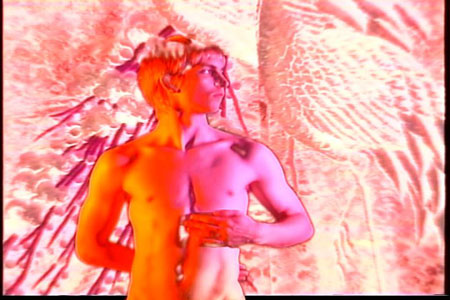Video
taped
dancers: Marc Berezowski, Thecla Schiphorst, Hans Seidemann, Douglas
Huffman
Recorded
singers:
David Dong Qyu Lee, David Garfinkle, counter-tenors
Live Performance: Marcel van Neer, tenor
Videos
by
Thecla Schiphorst and Barry Truax

These
songs are part of my opera Powers of Two,
specifically the act featuring a gay male Artist who seeks
guidance from the Seer (a counter-tenor heard on tape), an
androgynous figure who cannot walk or speak, but who
dispenses wisdom through images and song, and eventually
finds insight through blindness. The Artist misunderstands
the Seer, turning each reference to its opposite, but
still creating beautiful songs. For instance, “the armed
man is to be feared” becomes “the armed man is to be
desired”. Each song is accompanied by a video and an
historic musical and poetic reference symbolizing artistic
expression through the ages. In order, these are the 15th
century French tune, L'homme armé (The Armed Man);
Monteverdi's Combattimento di Tancredi e Clorinda;
the Liebestod from Wagner's Tristan und Isolde;
and the ending of Stravinsky's Oedipus Rex in
which the blinded king is accepted by his people. Besides
the sung text, poetic excerpts from Marino, Cavalcanti and
Rilke are heard.
1. L’homme armé
Seer (on tape):
I give you images,
Images to live for,
The image of your secret soul,
The mirror of your heart.
I give you images.
Video: Tape One
begins. Gradually, a static image appears in the form of a
male dancer (representing the classical beauty of
Antinous, the favourite of Hadrian), his partly bare back
to the screen and one hand visible. The Artist imitates
the dancer's movements and interact with the video
image. During the video, only the dancer's torso and head
are visible, and the camera follows his hands which caress
his skin.
Tape: stretched,
resonant version of sung L'homme armé (15th c.)
Seer: L'homme,
l'homme,
l'homme armé, l'homme armé,
L'homme armé doibt on
doubter, doibt on doubter.
On a fait partout crier
Que chascun se viengue armer
D'un haubregon de fer.
L'homme, l'homme, l'homme armé,
l'homme armé,
L'homme armé doibt on doubter, doibt
on doubter.
Tape: The
man, the man, the arm-ed man, the arm-ed man,
The arm-ed man, is to be
feared, is to be feared.
Everywhere it has been proclaimed
That everyone should arm himself,
With an iron coat of mail.
The man, the man, the arm-ed man,
the arm-ed man.
The arm-ed man, is to be feared, is
to be feared.
Artist: (in
reference to the male dancer of the video image)
The man, the man, this arm-ed
man,
This arm-ed man is to be desired.
Everywhere I shall proclaim
That I alone desire this man
With an iron coat of mail.
Artist: I
sing, Love, of thy warrior fair, and tell
Of all the mortal miseries I
knew,
How I was vanquished by a glance and
fell
Snared by a curl, a grievous tale
but true!
Two lovely eyes were weapons whence
I lay
With troubled soul transpierced, and
tears did flow
Instead of blood for many and many a
day;
Thou, by whose daring prize and
praise belong
To my victorious adversary, though
Dost kill the heart, givest life
unto the song.
Tape: Io
canto, Amor, da questa tua guerriera
quant'ebbi a sostener mortali
offese,
come un guardo mi vinse, un crin mi
prese
istoria miserabile, ma vera!
Due begli occhi fur l'arme onde
trafitta
giacque, e di sangue in vece, amaro
pianto
sparse lunga stagion l'anima
afflitta.
Tu, per lo cui valor la palma e 'l
vanto
ebbe di me la mia nimica invitta,
se desti morte al cor, da vita al
canto.
Giovambattista Marino
(1569-1625)
2. Tancredi and Clorinda
Tape: various
female and male voices (opposite to their actual gender):
I am a man / I am a woman
Video: Tape Two
begins in which a female dancer appears as Clorinda,
assuming the male role of a warrior. She enacts the story
of the battle of Tancredi and Clorinda in which he, not
recognizing his love, engages her in battle and kills her.
As she dies, the camera moves up her body and 'discovers'
her blond hair.
Tape: stretched,
resonant sung version of the opening of Monteverdi's Combattimento:
Seer (on tape):
Tancredi che Clorinda un'uomo stima
vol ne l'armi provarla al
paragone.
Artist: Clorinda,
who
wished Tancredi to be her lover,
Seeks forthwith to engage him
in mortal combat.
Tape: Tancredi,
who believed Clorinda to be a warrior,
[Clorinda, who believed
Tancredi to be a warrior]
Seeks forthwith to engage her[him]
in mortal combat.
Vuol ne l'armi provarla: un uom la
stima
degno a cui sua virtů si paragone.
Va girando colei l'alpestre cima
verso altra porta, ove d'entrar
dispone.
Segue egli impetuoso, onde assai
prima
che giunga, in guisa avien che
d'armi suone,
ch'ella si volge e grida: - O tu,
che porte,
che corri sě? - Risponde: E guerra e
morte.
Tasso: Gerusalemme
Liberata XII:52
e guerra e morte / war and death
(drum)
amore e vita / love and life
(bell)
Artist: You,
who do breach mine eyes and touch my heart,
And start the mind from her
brief reveries,
Might pluck my life and agony apart,
Saw you how love assaileth her with
sighs,
And lays about him with so brute a
might
That all my wounded senses turn to
flight.
Tape: Voi,
che per gli occhi mi passaste al core
E destaste la mente che
dormia,
Guardate a l'angosciosa vita mia
Che sospirando la distrugge Amore.
E' vien tagliando di si gran valore
Ch' e' deboletti spiriti van via.
Guido Cavalcanti
(1255-1300): Sonnet I
Tape: stretched,
resonant version of Monteverdi's Combattimento:
Seer: ella
mentre cadea, la voce
afflitta movendo disse le parole estreme,
parole , parole ch'a lei novo
spirto adita.
Tape: She can
no more oppose him,
her voice will scarce obey
her,
Yet faintly she breathes her last
words,
Her last words that yet a new spirit
infuses.
Ella, mentre cadea, la voce afflitta
movendo, disse le parole estreme;
parole ch'a lei novo un spirto
ditta,
spirto di fé, di caritŕ, di speme:
virtů ch'or Dio le infonde, e se
rubella
in vita fu, le vuole in morte
ancella.
Tasso: Gerusalemme
Liberata XII:65
Artist: Love,
who hath drawn me down through devious ways,
Hath from your noble eyes so
swiftly come!
'Tis he who hath hurled the dart,
wherefrom my pain,
First shot's resultant! And in
flanked amaze
See how my affrighted soul recoileth
from
That sinister side wherein the heart
lies slain.
Tape: Questa
vertů d'amor che m'a disfacto
Da' vostr' occhi gentil
presta si mosse;
Un dardo mi gitto dentro dal fianco.
Si giunse ritto 'l colpo al primo
tracto,
Che l'anima tremando si riscosse,
Veggendo morto 'l cor nel lato
manco.
Guido Cavalcanti: Sonnet
I (trans. by Ezra Pound)
3.
Tristan
Tape: Why,
Isolde [Tristan], why this to me?
When what I had not grasped
before
Was finally made clear to me.
Video: Tape
Three begins and shows the male dancer from the first
video in female attire, wearing the white fringed scarf.
This image fades in and out of a slow motion image of the
male dancer pulling the scarf down over his face; at the
end of the tape, his face (with eyes closed) finally
appears.
Tape: stretched,
resonant version of Wagner's Liebestod:
Seer: Höre
ich nur diese Weise, die so wundervoll und leise.
Artist: Why,
Tristan, why this to me?
When what I had desired
before
Was finally denied to me.
Tape: Do I
alone hear this melody
Which, so wondrous and tender
in its blissful lament,
All-revealing, gently pardoning,
rises above,
Blessedly echoing and ringing around
me?
Höre ich nur diese Weise, die so
wundervoll und leise,
Wonne klagend, alles sagend, mild
versöhnend aus ihm tönend,
in mich dringet, auf sich schwinget,
hold erhallend um mich klinget?
Wie sie schwellen, mich umrauschen,
soll ich atmen, soll ich lauschen?
Richard Wagner, Tristan
und Isolde, Act 3
The male dancer
again inspires the Artist in the following song.
Artist: But
the living all make the mistake of dividing too sharply;
Angels (they say) often did
not know if they walked
among the living or the dead. The
perpetual torrent
... drowns them out in each.
... once when they mourned for Linos
tentative primal music pierced
brittle despair;
only when the room felt the shock
of the almost god-like youth's
sudden departure forever
the emptiness started to vibrate
with that motion
which now uplifts us and comforts us
and helps us.
Tape: Aber
Lebendige machen
alle den Fehler, dass sie zu
stark unterscheiden.
Engel (sagt man) wüssten oft nicht,
ob sie unter
Lebenden gehn oder Toten. Die ewige
Strömung
reisst durch beide Bereiche alle
Alter
immer mit sich und übertönt sie in
beiden.
Ist die Sage umsonst, dass einst in
der Klage um Linos
wagende erste Musik dürre Erstarrung
durchdrang;
dass erst im erschrockenen Raum, dem
ein beinah götterlicher Jüngling
plötzlich für immer enttrat, das
Leere in jene
Schwingung geriet, die uns jetzt
hinreisst und tröstet und hilft.
R. M. Rilke: Duino
Elegies I (trans. by Norbert Ruebsaat)
4. Welcome Oedipus
Voices (on tape):
I bid you farewell.
(stretched, resonant version of the
choral ending of Oedipus Rex )
Vale, vale Oedipus, miser
Oedipus noster,
Te amabam, Oedipus, tibi valedico,
Oedipus, tibi valedico.
Video Tape Four
begins, showing a male dancer rotating against an equally
magnificent kimono.
Artist:
(accompanies his song with stylized hand and arm gestures)
Welcome, welcome, welcome!
Seer: Vale,
vale Oedipus, miser Oedipus
Seer: Va - le
- di - co (chant-like)
Artist: Welcome,
Oedipus,
I love you, I embrace you.
Blessed Oedipus, I welcome
your new found sight.
Welcome Oedipus, my own dear
Oedipus.
I love you, Oedipus, I embrace you
in me.
Seer: Di -
co (chant-like)
Artist: (turns
and approaches the video screen where the video tape is
finishing)
I embrace you in me. I
embrace you in
me.
Seer: Pa -
ro - le (sung)
O - m

